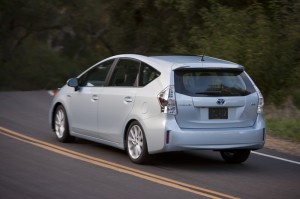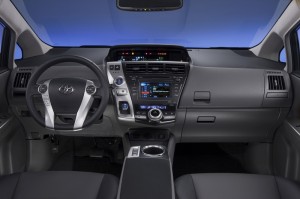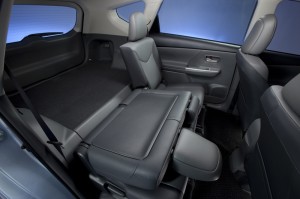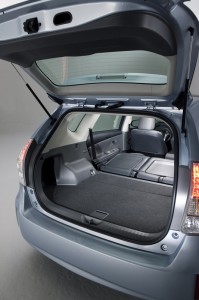 In the highly charged and uber competitive world of auto making, it’s never a good thing to rest on your laurels. With the launch of the 2012 Toyota Prius V, it’s clear that Toyota has decided that in order to keep its standing as the dominant hybrid automobile maker, it had to (literally) expand its flagship model, the Prius.
In the highly charged and uber competitive world of auto making, it’s never a good thing to rest on your laurels. With the launch of the 2012 Toyota Prius V, it’s clear that Toyota has decided that in order to keep its standing as the dominant hybrid automobile maker, it had to (literally) expand its flagship model, the Prius.
We’ve all known the Prius as a mid-sized hatchback since it debuted in Canada during the 2000 model year. Situated somewhere between the smaller Corolla and the larger Camry, the Prius maintained a certain size structure through its re-designs in 2004 and in 2009. The Prius has been a successful venture for Toyota as global sales of the Prius since its original debut in 1997 have recently exceeded 3 Million which makes it the best-selling hybrid – by far.
With competition in the hybrid market getting increasingly crowded now that just about everyone has at least one hybrid offering in their line-up, Toyota decided to add flexibility to the Prius by turning it into a family of vehicles instead of just one. With the launch of the Prius V, Toyota now offers a longer and larger version of the original and one better suited for the needs of eco conscious families. Having tested the 2010 Toyota Prius for the Enviro Dad Test Drive in the past, I was eager to see what a stretched out version of this baby would be like.
AT FIRST GLANCE
 While there is no mistaking that the Prius V is part of the Prius family, it’s also quite clear that the Prius V is not its sibling. From the C-Pillar back the vehicle is much different with a higher roof line and extended length. While this new stretched design is rooted in function as opposed to fashion, I can’t help but remark about how the look and design leaves me less than enthused.
While there is no mistaking that the Prius V is part of the Prius family, it’s also quite clear that the Prius V is not its sibling. From the C-Pillar back the vehicle is much different with a higher roof line and extended length. While this new stretched design is rooted in function as opposed to fashion, I can’t help but remark about how the look and design leaves me less than enthused.
Since first laying eyes on it, I had this strange sensation that I had seen something like it a long time ago. This déjà vu sensation has dogged me for some time now, and only recently did it hit me…although I’m not sure the folks at Toyota will love me for sharing. When I see the Prius-V, I can’t help but think that to some degree it reminds me of…(brace yourself) the AMC Pacer wagon. It also perhaps explains why I had this burning desire to crank up Bohemian Rhapsody during my week driving the Prius V around. I’ve linked images of the Pacer for those to see if you agree.
BEHIND THE WHEEL
 Someone buying the Prius V needs to know that this is not a car about handling and performance. While some of the newer luxury hybrids have been built to perform, the Prius V sticks to its core of being a fuel efficient vehicle.
Someone buying the Prius V needs to know that this is not a car about handling and performance. While some of the newer luxury hybrids have been built to perform, the Prius V sticks to its core of being a fuel efficient vehicle.
The Prius V operates with the same 1.8 litre 4 cylinder gas engine combined with a 60 KW electric motor, producing a net 138 horsepower that the traditional Prius offers. The original was never known as a speedster either and now that the Prius V adds more weight to the same propulsion system, well…you don’t want to be in a hurry behind the wheel of this car. The Prius V has a 0 to 100 km/h time of 11.6 seconds, so it’s really about getting there efficiently and not quickly with this vehicle.
While unspectacular in pep, it drives and handles relatively well. The regenerative brakes will always be something to get used to, and the occasional jumpiness of hybrids can catch a novice hybrid driver off guard, but generally it drives as one would expect it to.
THE GREEN FACTOR
Where the Prius V does excel though is in its multitude of eco-friendly attributes.
 Yes, this car is good on gas. While it carries a posted rating of 4.3 L/100km (city) and 4.8 L/100km (hwy), its real world numbers are about 10-15% above that. I was typically in the 5 to 6 L/100km range during my week in the Prius V, but these are very solid numbers notwithstanding. One of the challenges Toyota faced with stretching the original Prius would be the extra weight and its impact on fuel efficiency. To offset this, the engineers at Toyota used some ingenuity.
Yes, this car is good on gas. While it carries a posted rating of 4.3 L/100km (city) and 4.8 L/100km (hwy), its real world numbers are about 10-15% above that. I was typically in the 5 to 6 L/100km range during my week in the Prius V, but these are very solid numbers notwithstanding. One of the challenges Toyota faced with stretching the original Prius would be the extra weight and its impact on fuel efficiency. To offset this, the engineers at Toyota used some ingenuity.
Through the use of high tension steel and aluminum in the framing of the Prius V, engineers were able to keep the increase in weight to a modest 105 kg when compared to the Prius. The panoramic sunroof is made with a resin that is said to be about 40% lighter than glass. While it doesn’t open up, it’s still enjoyable. Besides the motor to open the sunroof would just add weight anyway.
There is an interior option with the Prius V to utilize a “Leatherette” synthetic seating material. The good part about this is that it attempts to simulate real hides but emits 99 per cent fewer volatile organic compounds during manufacturing. The bad part is that to me, it looked like a synthetic substitute and truthfully, for the effort I’d prefer to see a premium cloth interior instead.
THE FAMILY FACTOR
 Eco conscious families will certainly like the Prius V when compared to the mainline Prius. The 445 litres of cargo space that the Prius offers with the seats up is dwarfed by the 971 litres offered in the Prius V. If you were to put the rear seats down in the Prius V, you’d have cargo space comparable to the Venza or even the RAV-4.
Eco conscious families will certainly like the Prius V when compared to the mainline Prius. The 445 litres of cargo space that the Prius offers with the seats up is dwarfed by the 971 litres offered in the Prius V. If you were to put the rear seats down in the Prius V, you’d have cargo space comparable to the Venza or even the RAV-4.
I had no difficulty in loading six full reusable grocery bins in the back cargo area when I went grocery shopping with my daughter. The cargo area would easily fit 2 or maybe 3 hockey bags and I could see 3 or 4 sets of golf clubs being doable as well. Access to the cargo area via the rear hatch is wide and easily accessible.
For those with a penchant for techie toys in automobiles, the Prius V is equipped but not over-stocked. Most of the fun stuff though will only come with the upgraded packages. My tester came with the Touring + Technology package which provided a premium (relative) sound system, voice activated DVD Navigation system, a pre collision system, dynamic radar cruise control which adjust your cruising speed when cars get too close ahead, rearview camera that is visible through the navigation screen, LED headlamps and Bluetooth configuration among other things.
SUMMARY
Toyota has long been the leading manufacturer when it comes to hybrid automobiles. With the launch of the Prius V they have essentially created a new category for hybrid vehicles and while they remain alone in this area, it likely won’t be long before others jump on board. When that happens, Toyota will need to address where it’s weak and further improve where it excels.
The Prius V is not a fun car to drive if you are accustomed to cars that perform. Its lack of power and its merely adequate handling, combined with a less than stellar exterior design will make hard core drivers look elsewhere.
However the Prius V is an exceptional car for any family of up to 5 that want to make solid eco-decisions with their choice of vehicle without sacrificing the space and functionality needs of a typical modern family.
When considering the Prius V, it is very wise to determine which side of the above equation you sit on, and then make your choice accordingly. This isn’t a car with much of a middle ground, as it’s either going to really work for you, or it won’t.
BY THE NUMBERS (Out of 10)
LOOK/DESIGN – 7.0
DRIVE – 7.5
THE GREEN FACTOR – 9.0
THE FAMILY FACTOR – 9.0
TECHIE STUFF – 8.0
VALUE – 7.5
(MSRP as Tested $38,575)
OVERALL SCORE – 8.0


Considering I’d be trading up from 10yo beat up Focus, I suspect i wouldn’t notice the lack of performance! I like that Toyota has made it more family-friendly. Wonder how the performance compares to 100% electrics?
Thanks Marty for your comment. It would be hard to compare the Prius V with any 100% EV’s just yet since The Volt is a 4 seater and the Leaf is a sub compact. I’ve driven all three and I’d say that in direct comparisons they actually perform very similar. In Detroit I saw a Nissan concept all EV family van, so that will be the true test if they ever get it to showrooms!
Thanks again!